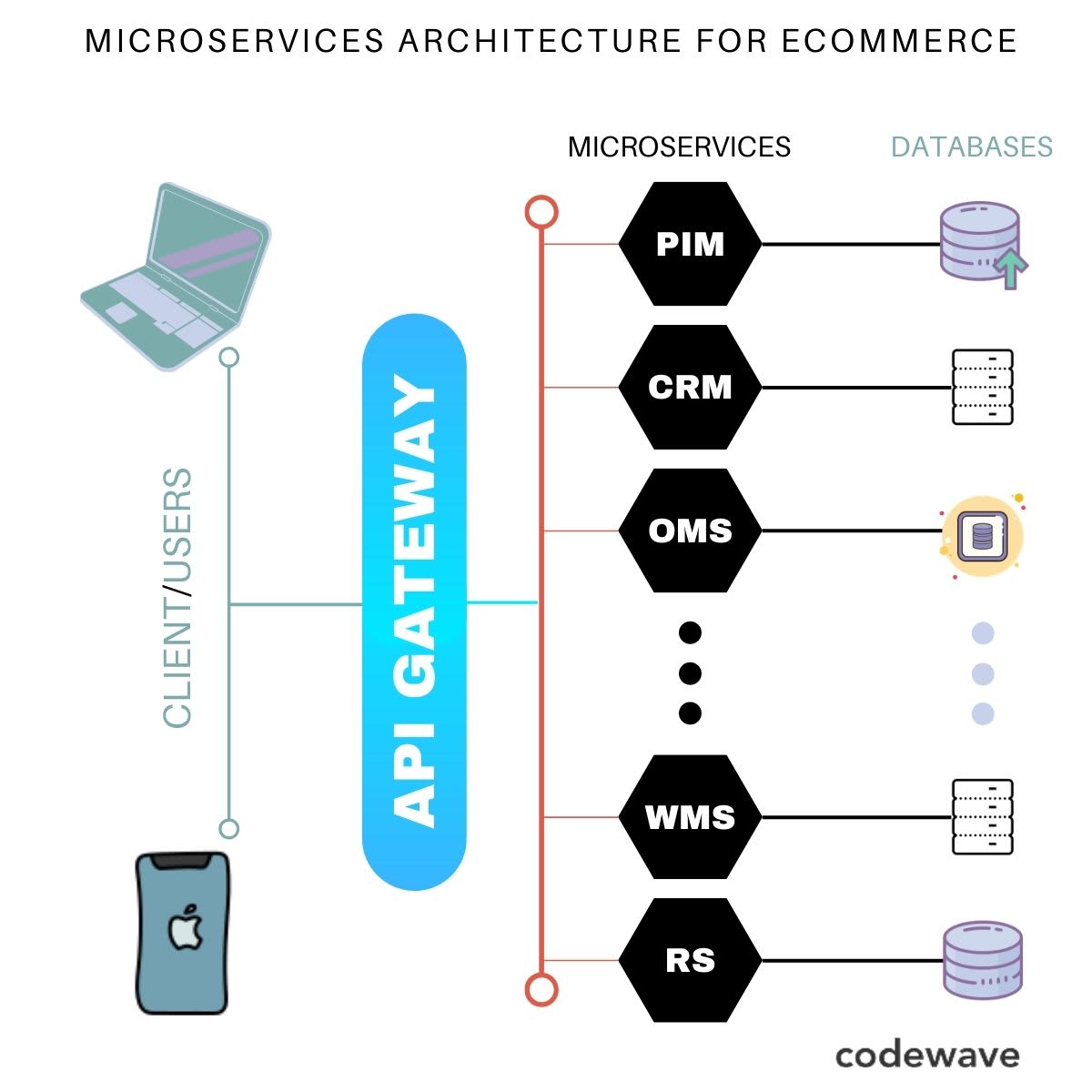“Building Modern & Scalable Retail & eCommerce Solutions Using Microservices Architecture And Agile Methodology For The Ever Informed Digital Age”.
– codewave.com
Tech teams in 2023 have an overwhelming amount of options to build eCommerce applications. One popular option is the microservices architecture for eCommerce app development. It is all buzz in the tech circles. Some advocate for it as the best approach to build your eCommerce solution.
But, is the best way, best for your company too?
Does eCommerce microservices architecture fit in the existing tech infrastructure of your company?
Is the solution long term?
Is it sustainable, scalable, secure?
You need years of expertise to answer these questions.
For now, we’ve got you covered. You can rely on the experience of our eCommerce solution architects.
Read this insight to find out everything related to microservices architecture for eCommerce application development.
What is microservices architecture?
- Microservices architecture is a development approach for rapidly building scalable, large scale, and complex digital solutions.
- As the name goes, it is a collection of small (micro) independent services.
- These micro-services are loosely coupled with each other and can share resources and exchange data using APIs.
With microservices architecture, large complex software systems are decomposed into several smaller components which can be independently designed, developed and deployed.
In microservices architecture, overall business functionality is delivered by cohesively stacking several smaller independent services.
Generally, each microservice is built to deliver a specific business capability and is maintained by very small teams. Because these services are independent of each other, development teams responsible for specific microservices can choose technologies of their choice to build a particular microservice.
Benefits of Microservices Architecture
- Microservices enables businesses to introduce new features and accelerate innovation without bothering the overall application architecture.
- Microservices by design is suited for agile development.
- Businesses can continuously develop, test and deploy features.
- Just like how new features can be added, redundant features & microservices can easily be decoupled from the overall application.
Why should retail enterprises consider microservices architecture for ecommerce app development?
It’s not good to be limited by the on-premise server capabilities.
Legacy architecture should no longer obstruct innovation & act as a growth ceiling for your retail ecommerce enterprise.
With cloud computing – the sky’s the limit.
But whether a retail enterprise staring at digital transformation should go for microservices architecture for eCommerce or not should be dictated by whether it fits the organisational goals & resources or not.
In general, eCommerce microservices architecture are associated with following perks:
1. Autoscaling & Resilient Applications
In 2019, 1.92 Billion people bought goods or services online.
The retail e-commerce industry is already as big as $4Tn+ and it will continue to grow in the 202Xs.
To cater to such huge demands, your ecommerce architecture must be robust, secure and scalable.
During discounted sales and in festive seasons, traffic to large retail ecommerce sites can spike to 10s of millions within seconds. If your ecommerce app slows down or breaks in such a scenario then it translates into losing a lot of profit.
But businesses are to maximize profits. Right?
So, enterprises need solutions that can auto scale-up and scale down to serve customer demands.
Microservices architecture for eCommerce applications in the cloud can autoscale specific services on need basis and is highly resilient.
2. Business Agility & Innovation
Also, the fierce competition in the ecommerce industry requires businesses to continuously innovate and wow customers with convenience and smooth online shopping experience.
Innovation involves constant flirting with new features & strategies.
Again, to accelerate innovation businesses need an agile development approach. And because microservices architecture for eCommerce lets you easily add/remove specific services without disturbing the overall application, techies are all rage about using it for ecommerce app development.
3. Code Reusability & Accelerated Development
In the eCommerce microservices architecture,
- Each module is independent of other services.
- These services are loosely coupled together to deliver business functionality.
- Same microservice can be used/integrated at multiple places.
For example, legacy architectures have product price engines embedded in their main application code. Though, prices can easily be updated in such engines but it is hard to reuse it elsewhere.
Code Reusability in eCommerce Microservices architecture explained with business use-case
- Let’s suppose your legacy architecture for price engine was developed in PHP and now your enterprise launches an Alexa skill developed using python for voice commerce. It would be tough to use the same PHP code and obtain a price for the Alexa powered voice commerce application.
- In contrast, integrating a price engine using microservices architecture for eCommerce would have been a cakewalk. If the price engine was developed as an independent microservice, irrespective of the technologies involved, it could have been easily stacked up with any other service requiring price.
What are the alternatives of eCommerce microservices architecture?
Tech industry is always evolving so are application architecture patterns. Though microservices architecture is the biggest buzz of the last decade and still continues to be, but there are some other architectural patterns zizzing for its fair share of attention.
- Serverless architecture is the present sensation among the solution architects.
- Microkernel, Layered and event-driven architecture are some other popular software design patterns.
Some other resources for you :
Read about MERN stack and MEAN stack which are some of the popular ecommerce application development stacks.
Also read, ReactNative Vs Flutter for mobile application development.
Read more on how you can embrace and lead retail digital transformation in your industry.
Microservices architecture for eCommerce app development
Finally, getting to the meat of this insight.
Microservices architecture for ecommerce enables enterprises to effectively implement omnichannel retail approach.
Additionally, retailers can complement their eCommerce microservices architecture by using serverless for implementing IoT and beacon technologies and deliver personalized in-store experience to customers.
How do you implement microservices architecture for eCommerce applications?
Microservices architecture for eCommerce is a good fit for cloud-native application development. Here’s why:
- eCommerce landscape and retail business in general is evolving quickly.
- New features are continuously introduced for driving engagement, sales and customer loyalty.
- Plus, in the festive seasons merchants face scalability challenges for exponential traffic spikes.
- Microservices is a pain-killer for all these challenges.
- For an effective omnichannel ecommerce strategy, exploiting microservices, serverless, beacon, AI and data would be the right approach.
A not so complex multi-vendor eCommerce microservices architecture would consist of:
- Independent product catalog and inventory microservices,
- Cart,
- Checkout and transaction microservices,
- Customer profiles microservices,
- Ratings and reviews microservices and
- Vendor profile microservices.
Client-facing UI interface itself could be an independent microservice and can be interfaced with ecommerce backend microservices to dynamically load UI elements and data via restful APIs.
Next, we’ll discuss some of the ecommerce specific microservices architecture components. For detailed consultation, feel free to approach our retail digital transformation consultants.

Product Information Management (PIM): Microservices architecture For Ecommerce Applications
Product Catalog Microservices architecture For eCcommerce application –
For a niche ecommerce application, say boy’s jeans website or protein supplement website, the set of product attributes might be limited in number but for a marketplace ecommerce application, the diversity of products is quite huge and so is the set of product’s characteristic attributes.
The set of attributes keeps on growing with the catalog size and product variants.
For niche websites, sql databases might work but for an scalable ecommerce application, noSQL databases are a better fit.
PIM would also contain some other microservices like –
- Product media & metadata microservices for ecommerce applications
- Product ratings and reviews microservices
- Product inventory microservices
Customer Relationship Management: Microservices architecture for eCommerce App Development
Customer profile microservices architecture for ecommerce apps –
Ecommerce has a huge market reach and your customers could be coming from unexpected geographical regions. It’s always good to build data around your customers for personalising their user experience.
Customer profile database attributes are generally consistent in nature. So, a relational database as well as document-object database would be suited.
Retail enterprises may also consider managed noSQL cloud databases like Google’s Datastore or Amazon’s DynamoDB.
CRM for delivering personalized marketing communication and some other use cases could also incorporate following microservices –
- Customer Verification Microservices For Ecommerce
- Customer Address Validation Microservices
- Customer Payment Details or Card Management Microservices
Other than PIM and CRM, a full-fledged microservices ecommerce architecture would also contain:
- Payment gateway & transaction microservices
- User activity tracking and analytics microservices
- Shipping microservice
- Notifications microservice
- Search microservice
- Recommendations microservice
- Loyalty programs & coupon microservices
- Ads microservices for distributed ecommerce applications
For any further information, brainstorming or for developing microservices for ecommerce applications get in touch with our retail digital transformation ninjas.
Codewave is a design thinking led digital transformation company enabling organisations with playful innovation using AI & ML, IoT & Edge, AR, VR, Cloud, Blockchain, and Data.







